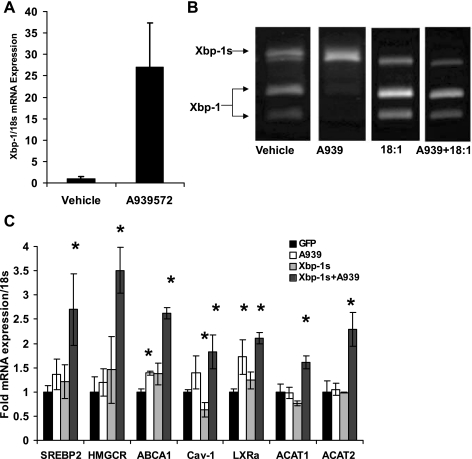Fig. 5.
Loss of SCD-1 activity increases the transcriptionally active form of X-box binding protein-1 (Xbp-1s)-mediated induction of cholesterol synthesis. Modest increases in FC can induce cell stress; therefore, we assessed the degree of Xbp-1 mRNA induction with SCD-1 inhibition. A: cell stress transcription factor Xbp-1 mRNA was significantly increased with 1 μM A939572 treatment for 18 h. B: Xbp-1s was assessed by resistance to PstI digest and showed that loss of endogenous MUFA synthesis increased splicing, whereas replenishment with 10 μM oleate was sufficient to restore normal function. C: the constitutively active Xbp-1s adenovirus (10 GFU/ml) was used to assess the ability of endoplasmic reticulum (ER) stress to induce cholesterolgenesis in the presence or absence of SCD-1 activity. In GFP-, A939572-, or Xbp-1s-treated cells, there was no effect on cholesterol synthesis and only a slight inductin of LXRα and ABCA1. In the absence of SCD-1 activity, Xbp-1s increased cholesterol synthesis gene expression [stearoly regulatory element-binding protein-2 (SREBP-2), HMG-CoA reductase (HMGCR), acyl-CoA:cholesterol acyltransferase (ACAT)1, and -2] and LXR target genes (LXRα, ABCA1, and Cav-1).

